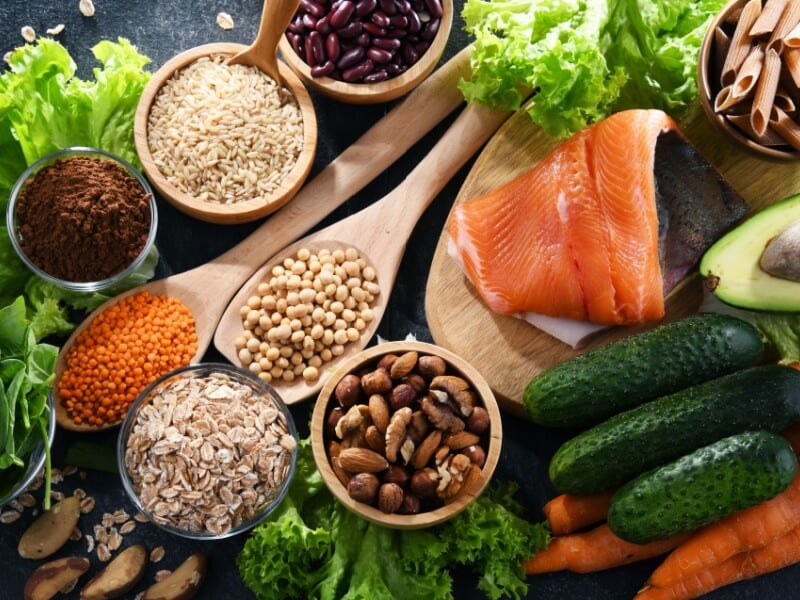DASH diet explained
High blood pressure (hypertension) can increase your risk of heart and circulatory diseases. But changing what you eat can make a difference.
In the 1990s, a new diet was designed to lower blood pressure by researchers at the National Heart, Lung, and Blood Institute in the United States.
It was called DASH diet, which stands for ‘Dietary Approaches to Stop Hypertension’.
The aim of the diet is to cut down on salt (sodium) and eat more nutrients like fibre, potassium and calcium that can help to lower blood pressure naturally.
It contains lots of fruits, vegetables, wholegrains and low-fat dairy products, and is low in salt, saturated fats, sugary foods and alcohol.
The standard version of the diet limits your sodium intake to 2,300mg or less a day, which is around 6g or 1 teaspoon of salt.
And a lower-sodium version of the diet – with no more than 1,500mg sodium or around 4g or three-quarters of a teaspoon of salt a day – may help to lower blood pressure further.
Benefits of the DASH diet
To find out if you have high blood pressure, your doctor or nurse will take your blood pressure with a monitor that involves having an inflatable cuff positioned around your upper arm.
You will be diagnosed with high blood pressure if the top number on the monitor is over 140mmHg (this is the systolic blood pressure) and your bottom number is over 90mmHg (this is the diastolic blood pressure), or over 135mmHg and 85 mmHg if you’ve measured your blood pressure at home.
Many studies have shown that the DASH diet can help you reduce these numbers to a healthy level.
One large study published in 2019 in the journal Nutrients looked at 7 meta-analyses (including 15 observational studies and 31 controlled trials) of the DASH diet.
It showed that the diet was linked to a 5.2mmHg decrease in systolic blood pressure (the top number) and 2.6mmHg decrease in diastolic blood pressure (the bottom number).
The study also found that the diet was linked to a 20 per cent lower risk of cardiovascular disease, such as heart attack, stroke or coronary heart disease.
As well as high blood pressure, research suggests the DASH diet may improve other risk factors of heart and circulatory diseases too, such as high cholesterol, blood sugar levels and excess weight.
DASH diet food plan
The DASH diet recommends eating a certain number of servings (portions) of each food group. It also explains how much of each food group counts as 1 serving.
The number of servings is slightly different depending on how many calories you need, but for a 2,000 calorie a day diet, this would be:
DASH diet recipes
As long as you’re aiming for the right balance of different food groups, you do not have to eat any specific foods or meals to follow the DASH diet.
A day of eating according to the diet could look like this:
Breakfast: Bircher muesli.
Lunch: Black bean and sweet potato burritos.
Snacks: Salmon pate on wholegrain toast and a piece of fruit like a banana or apple.
Dinner: Baked biryani chicken and rice.
Dessert: Yogurt coated strawberries.
This would contain roughly:
- 9 ½ portions of fruit and vegetables
- 7 portions of wholegrains
- 7 portions of lean meats, fish and eggs
- 1 ½ portions of dairy
- 3 ½ portions of nuts, seeds and beans
- 1.33g of salt
Discover more heart-healthy recipes.
DASH diet vs Mediterranean diet
The Mediterranean diet is another style of eating often recommended for heart health.
Like the DASH diet, it’s high in fish, vegetables, fruits, wholegrains, nuts and seeds, and low in salt, added sugar, saturated fats and red meat.
The Mediterranean diet does specifically recommend eating more oily fish, which contains heart-healthy omega-3 fatty acids. And the DASH diet includes several daily servings of low-fat dairy products because calcium is known to lower blood pressure.
In general, the DASH diet is more structured, with a specific number of servings of each food group.
Meanwhile, the Mediterranean diet is more flexible, which may be easier to follow in the long term. It’s often described as a way of life, not just a diet.
But both diets can help you look after your heart, so the one you choose to follow depends on what works for you and your lifestyle.
What to read next…
